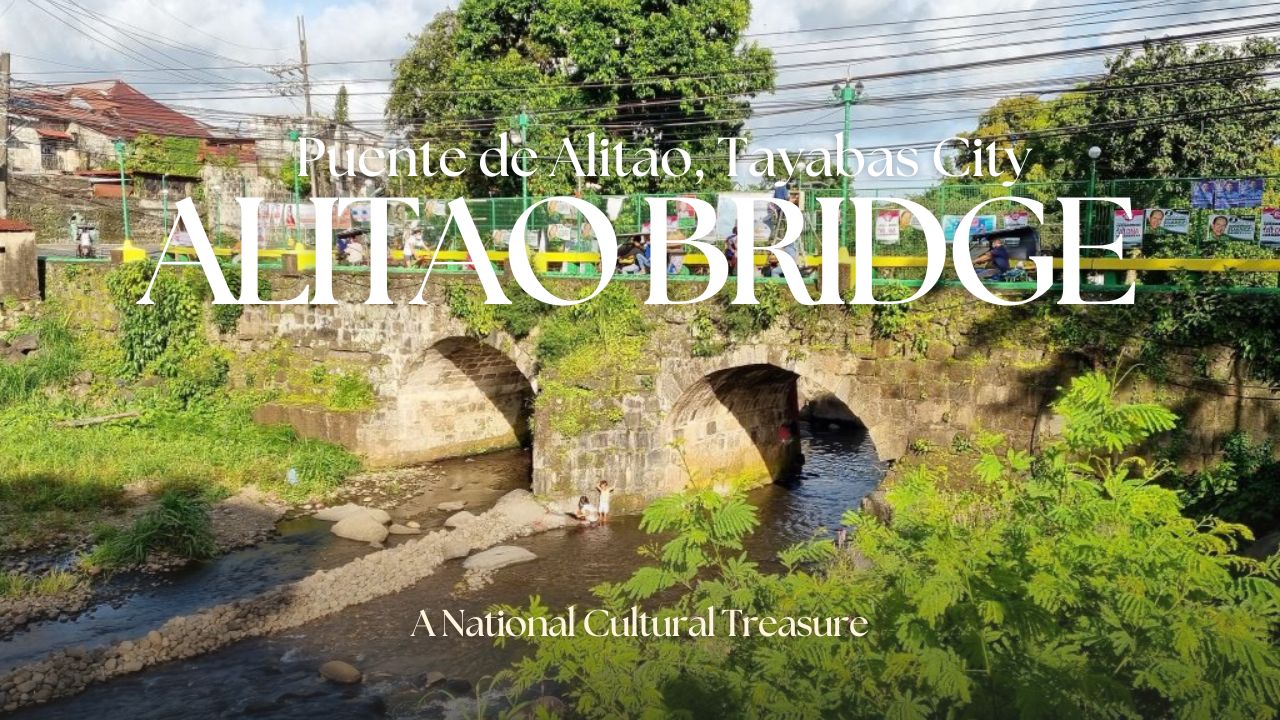ALITAO BRIDGE: Puente de Alitao in Tayabas City
Alitao Bridge: A Journey to the Spanish Colonial Past
Located in Tayabas City, Alitao Bridge, also known as Puente de Alitao, offers a glimpse into the historical and architectural richness of Quezon Province. Built in 1823, this iconic bridge represents a significant link between the past and present, showcasing the region’s Spanish colonial heritage. Once constructed with wood in 1798, it was later rebuilt using stone, lasting many decades.
Alitao Bridge
Today, Alitao Bridge stands as a testament to Filipino resilience and culture. It continues to be a vital part of local life, allowing residents to traverse daily while reminding them of their historical roots. The bridge’s importance led to its recognition as a cultural treasure, highlighting its inclusion in the Philippine Registry of Cultural Property.
The preservation efforts surrounding Puente de Alitao are supported by the National Cultural Heritage Act. This ensures that such historical structures remain protected and appreciated for generations to come. Its unique structure and historical importance make it a must-visit landmark for those interested in the rich tapestry of the Philippines’ colonial history.
Spanish Colonial Era
During the Spanish Colonial period, bridges like Puente de Alitao were crucial for connecting communities. Originally built in 1798 as a wooden structure by Don Jose Medio, it was reconstructed in 1823 using stone by Don Diego Urbano. This transformation marked the bridge’s importance in linking the old town to the población over the Alitao River. Such bridges are part of the Spanish colonial bridges in Tayabas that include notable names like Don Francisco De Asis and Queen Isabel II.
These bridges were not just functional; they were also symbols of Spanish engineering and influence. The use of local materials and architectural techniques reflects a blend of Spanish and local heritage, contributing to the cultural landscape of Tayabas City. Today, these bridges stand as testaments to the fusion of cultures and the resilience of historic structures.
Designation as a National Cultural Treasure
The Puente de Alitao has been designated as a National Cultural Treasure, underscoring its importance in cultural heritage. This designation is part of efforts by the National Museum and local government to preserve such historic landmarks. The bridge, alongside others in the Historic Bridges of Tayabas, is protected to maintain its legacy and continue its role in local history.
Recognizing Puente de Alitao as a cultural treasure ensures its protection for future generations. These efforts honor the craftsmanship of past builders and highlight the ongoing significance of these structures in the cultural identity of Tayabas City.

The Battle of Alitao
The Battle of Alitao, which occurred on November 1, 1841, stands as a pivotal event in the Filipino struggle against Spanish colonial domination. This conflict arose from the tensions between the colonial authorities and local religious movements, specifically involving the Cofradía de San José. The Cofradía, a religious brotherhood founded by Apolinario de la Cruz, known by his title Hermano Pule, sought to advocate for the rights and welfare of Filipino peasants and the local populace against the oppressive Spanish regime.

As the battle unfolded, Hermano Pule and his followers prepared to defend their beliefs and assert their rights. However, the Spanish colonial forces, commanded by Colonel Joaquin Huet, launched a well-coordinated attack against the Cofradía fighters, who were equipped with rudimentary arms and motivated by a fervent desire for justice. The Spanish troops, on the other hand, arrived with better military training, strategic organization, and superior firepower.
Despite the initial tenacity displayed by the Cofradía members, they were met with overwhelming resistance. The battle turned into a fierce confrontation, culminating in significant losses for the Cofradía. They suffered heavy casualties, which ultimately weakened their resolve and military capability. Tragically, Hermano Pule was captured during the conflict, marking a significant blow to the movement he had passionately led.
The aftermath of the Battle of Alitao not only underscored the violent struggle against colonial rule but also highlighted the friction that existed between the Spanish authorities and local religious leaders. This conflict marked a crucial moment in the ongoing history of resistance in the Philippines, laying the groundwork for future uprisings and movements against colonial oppression. The legacy of Hermano Pule and the Cofradía de San José would resonate throughout Philippine history, symbolizing the enduring spirit of resistance among the Filipino people.
Architectural Features
Stone Bridge Construction
Puente de Alitao was constructed using stone in 1823, a common method during that period. The bridge features sturdy arches, a typical characteristic of Spanish-era stone bridges in the Philippines. These arches were designed to distribute weight evenly, providing stability and durability.
This engineering marvel originally included four arches. Today, only two remain, along with the parapet, spandrel, and piers. The remaining structure reflects the mastery of historical stone bridge techniques that have withstood the test of time.
The bridge’s foundation sits firmly on the riverbanks, allowing it to withstand erosion and the force of the flowing river beneath. The stone construction not only highlights the engineering skills of the time but also adds to the aesthetic charm of the bridge.
Unique Design Elements
Puente de Alitao boasts several unique design features that distinguish it from other infrastructures in Tayabas, including the Malagonlong Bridge. Its low silhouette spans the Alitao River gracefully, blending naturally with the surrounding landscape.
One side of the bridge is flanked by a barangay park, while the other is bordered by the rushing waters. These features not only add to its visual appeal but also connect it with the local community as a vital crossing and a historic landmark.
These elements contribute to its designation as part of the Tayabas Historic Bridges, protecting it as a cultural asset. The intricate stone carvings and classical design further emphasize its historical significance and architectural beauty.
Cultural and Social Impact
Role in Local Traditions
The bridge is vital to many local traditions, having stood for centuries as a silent witness to cultural events. Puente de Alitao is often featured in festivities, serving as a ceremonial backdrop. The National Museum recognition of Tayabas’ colonial bridges as a National Cultural Treasure underscores its importance in the local history. The bridge helps link stories of the past with present customs, preserving the community’s heritage.
Tayabas’ annual events often include the bridge in parades or processions, highlighting its symbolic meaning to residents. Not just a piece of infrastructure, Puente de Alitao embodies the resilience and continuity of Tayabas’ cultural practices over time.
Influence on Modern Tayabas
Today, Puente de Alitao bridges the past with the present by influencing modern urban life in Tayabas City. The bridge retains its charm while serving practical purposes, linking the old town to the población. Though modernized, its historical essence remains intact.
The Local Government Unit views the bridge as crucial to urban planning and development. Despite legal challenges and population growth, the community continues to value the bridge’s role in daily life. It connects people to historical sites and cultural landmarks like the nearby Church of San Miguel.
Surrounding Environment
Natural Ecosystems
The bridge is located near the Alitao River, which flows into the Iyam River. These riverbanks host a variety of plant and animal life, contributing to the area’s natural ecosystem. Trees along the river provide shade and habitat for birds and small animals. The waters support fish and other aquatic life.
The natural landscape around Puente de Alitao creates a picturesque setting. Bai Creek is another nearby water feature that adds to the area’s ecological diversity. Vegetation near the water helps prevent erosion, protecting the surrounding land. This balance of natural elements is vital for preserving biodiversity in Tayabas and Quezon Province.
Impact on Local Communities
Puente de Alitao plays a crucial role in connecting various local communities in Tayabas. It serves as a vital passage for residents and supports daily commuting between neighborhoods. The bridge’s presence also influences social interactions and community ties, as people frequently use it to travel to markets, schools, and other key locations.
Legal battles and population growth have challenged the area’s environment, affecting the bridge’s surroundings. These changes sometimes lead to increased traffic and infrastructure development in Tayabas. Yet, the bridge remains a symbol of heritage for Tayabas City, contributing to a collective local identity. Its cultural significance continues to unite residents and visitors alike.
Preservation Efforts
Oplan Sagip Tulay Initiative
Oplan Sagip Tulay plays a significant role in preserving Puente de Alitao. This initiative focuses on protecting Spanish-era bridges in Tayabas, ensuring they remain a part of the country’s National Cultural Treasure. The Local Government Unit of Tayabas City works regularly to remove unwanted vegetation and clean the bridge’s masonry. This not only maintains the structure’s beauty but also its structural integrity. These efforts are vital for preventing deterioration that might be caused by adverse weather conditions or neglect. The active involvement of the community in this initiative further supports the bridge’s preservation and highlights the commitment to maintaining their cultural heritage.
Contributions from Local and National Organizations
Local and national organizations, like the National Museum, contribute to preserving Puente de Alitao. The National Museum provides expertise and resources for conservation projects. Their involvement ensures that restoration respects historical accuracy. Moreover, the Tayabas City Local Government Unit collaborates with these organizations to coordinate preservation tasks effectively. This teamwork integrates local efforts with national policies for cultural heritage preservation. Financial and technical support from these organizations enhances the sustainability of these efforts. These contributions ensure that Puente de Alitao remains a well-preserved symbol of Spanish colonial architecture for future generations.
Tourism and Accessibility
Visitor Information
Puente de Alitao stands as a testament to the architectural legacy of the Spanish era in the Philippines. Visitors to Tayabas City will find this National Cultural Treasure easily accessible. Situated amid lush surroundings, it invites exploration and offers scenic views of the Alitao River.
Tourists are encouraged to explore the nearby barangay park, which provides a relaxing atmosphere. It’s advisable for visitors to check local weather conditions as the area can be affected by seasonal rains, impacting accessibility.
Infrastructure for Tourists
Tayabas City has developed a network of infrastructures that support tourism around Puente de Alitao. The Historic Bridges of Tayabas, including Puente de Alitao, have been declared for protection, ensuring they remain preserved for future generations.
Parking facilities are available nearby, and signage has been improved to guide tourists. Efforts have been made to maintain pathways and viewing areas around the bridge, enhancing visitor safety and comfort. The city’s initiatives ensure that visitors can enjoy the bridge without encountering significant access issues.
Other Bridges of Tayabas
In Tayabas, several bridges stand as impressive examples of historical architecture from the Spanish colonial period. Puente de Malagonlong, the largest and considered the most majestic, was completed in 1850 and still endures as a bridge of beauty and strength.
Puente de Lakawan and Puente de Mate also contribute to the city’s heritage and have received recognition for their design and construction. Puente de la Ese and Puente de las Despedidas showcase their unique architectural features and important historical roles.
Each bridge tells a different story, like Puente de la Princesa and Puente de Tumuloy, which have been part of the cultural landscape of the city for centuries.

Frequently Asked Questions
What is the historical significance of the Puente de Alitao in Tayabas City?
Puente de Alitao was originally built in 1798 as a wooden bridge and was later reconstructed in stone in 1823. It stands as a representation of the Spanish colonial era and showcases the architectural style of that period. It served to connect various parts of Tayabas City and remains a significant landmark today.
How can I find the location of the Puente de Alitao in Tayabas City?
The Puente de Alitao is located over the Alitao River, linking the Munting Bayan to the población. It is situated near a barangay park, providing easy access and making it a notable point for visitors exploring Tayabas City.
Are there any old photos of the Puente de Alitao in Tayabas City available for viewing?
Old photos of Puente de Alitao can often be found in local history archives or community heritage sites. For those interested, checking with local heritage organizations such as Tayabas Heritage Channel may provide more information and access to visual records.
What is the connection between the Malagonlong Bridge and the Puente de Alitao?
Both the Puente de Alitao and the Malagonlong Bridge are part of the historical network of Spanish-era bridges in Tayabas City. While they serve the same historical period, they differ in design and purpose but together highlight the city’s rich colonial heritage in bridge construction.
What are some notable characteristics of the Malagonlong Bridge?
The Malagonlong Bridge is one of the longest Spanish colonial bridges in the Philippines. Known for its impressive length and series of arches, it showcases remarkable engineering and design. It remains an outstanding example of the craftsmanship and architectural style from the Spanish colonial period.
Can you list the historical bridges found in Tayabas City?
Tayabas City is renowned for its numerous historical bridges. Some of these include the bridges of Alitao, Isabel II, Urbiztondo, Don Francisco de Asis, Bai, Despedidas, Ese, Princesa, Malagonlong, Lakawan, and Mate. These bridges have been declared historical, highlighting their cultural importance.
Like, Follow, and Subscribe to OutofTownBlog.com on Facebook, Twitter, Instagram, and Pinterest, and Team out Of Town on YouTube for more Tayabas Travel Spots.
Read:






